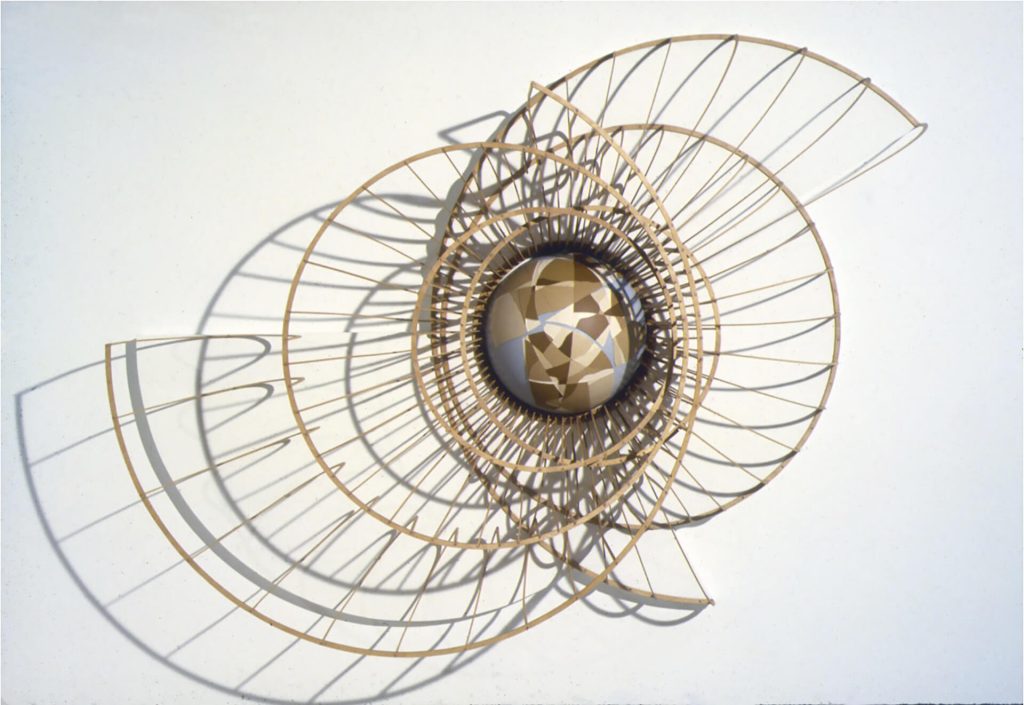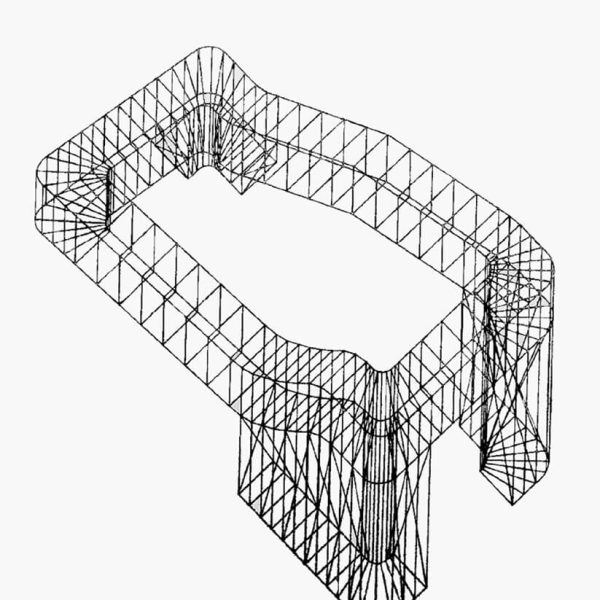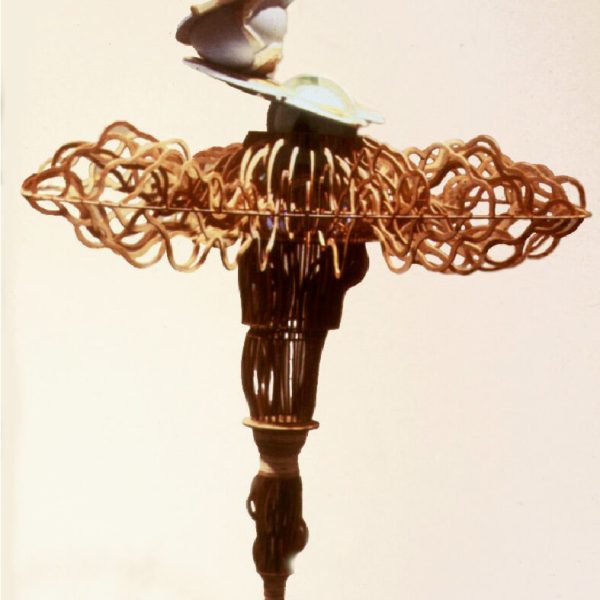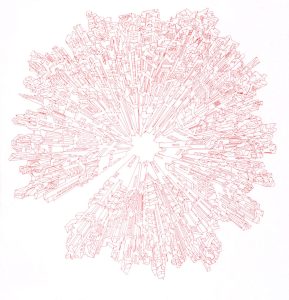Who is Joe Neill?
by Xavier Luccioni

Long ago according to artistic hierarchy, the sculptor was the person who cut stone. When the stone is broken it produces a seeming explosion of many tiny pieces that creates a tangled mass which gives the sensation of chaos. That is what happens when the unaccustomed eye crosses the barrier of the skin, the frontier of an envelope or the ramparts of the apparent.
Few artists have dared to venture into the interior of a stone. As a result this space became the domain of the scientist. To each his own space. Today we would like to break down the barriers between the different spheres of knowledge. But at the same time, these areas of knowledge or information want to protect their own identities. Thus making it difficult for each area to enter into the other even if they exist side by side.
So, let’s get to the point, who is Joe Neill?
He is a sculptor who does not carve stone, but penetrates into the matter of things using wood, cardboard and styrofoam. His work ressembles the motor of a car or an airplane that has been stripped naked of its protective metallic skin. They are like human machines or mechanical beings that are invulnerable to the peripeties of life. A kind of perfect flesh spared from the effects of time and protected from microbes by a very fine membrane. There are no concessions to the moment. Only the suggestion of a body in tension.
It is suprising but some people will wonder if this interaction of elements could have an additional level of meaning. Is he a sculptor or a mechanic or a sculptor who is a paleontologist? Does he not seem capable of reconstructing a dinosaur from a small part of it’s spinal column. Undeniably he is a sculptor/engineer who escaped from a research center or a sculptor/programmer able to transform, thanks to cardboard, the simulations from his powerful computer into real froms. Thus going from the virtual to the real. All of this being so calculated and precise, is it possible that it is due only to sculpture? We are well aware of the license given to creators which implies an exchange between the artist and society; Where in return for a useful contribution society allows the artist to create things that have no useful fonction.

Our era always demands an explanation, so, who is Joe Neill.
In a mechanized culture( don’t forget that he is american) his works would translate into an exitential compulsion to materialize the forces of movement that he feels as a living being. We can advance this explanation because our civilisation is dominated by the syndrome of cloning.
So, the sculptures of Joe Neill seem to manifest themselves as a narcissistic transfer but would reveal to the informed critic the ambiguous. This artist proposes “self portraits” which are without any kind of anthropomorphic form. Since Duchamp’s “Nu Decendant l’Escalier” and Picasso’s “Les Demoiselles d’Avignon” art is no longer subjected to the rigors of representation. Moreover, every contemporary object affirms more or less it’s utilitary identity. That is why an airplane or a car(two emblems of our times) would cease to have a reason to exist without their function. A car is driven, an airplane flies, a machine makes something, technology perfects the machine and science perfects technology. Our civilization differentiates itself from past civilizations by pretending to emphasize the efficient.
Now that seems pertinent!
So the positive heroes are called scientists. Because, they are the ones able to apprehend the ins and outs of ensembles that are made complexe by the multiplicitiy of parameters linked to the forces of movement. What movement? The movement of the living for the anthropolgist,the movement of life for the biologist who unties thread by thread the skeins of DNA or the movement of time for the astro-physicist engaged in calculating infinity.
And the artist?
For him it is more complicated. Especially, because Joe Neill constructs objects that serve no particular function except to express something. This artist spends hours glueing small pieces of wood together. He doesn’t even use “a time saving machine,” one of those big computers through which forms can pretend to improve themselves. He keeps glueing his “cells” together like a biologist would, but a biologist who gives himself the right to create his own living research objects. From these are produced lineages, couplings, copulations and then reproductions. It’s from all this that the stuff of life begins and a world is created.
Here again we have a coherente explanation.
To each one his own but for me Joe Neill is simply a clockmaker. In fact a Master Clockmaker. The one who controls movement by creating rigorous mechanisms destined to measure time. Their keystone is the dial but without hands because time needs not explain itself with numbers. The hours, minutes and seconds are posted everywhere and all the time thus losing their significance. There are even small throwaway clocks designed by artists and produced in huge quantities for use in gilt frames. It is because of this that time is no longer absolute. Except, for our “Clockmaker”. Since he no longer has to tell the real time, he can devote himself to the essentials. To movement without being preoccupied with time. He carves each gear, models each spring and polishes each piece one after the other. For him each piece belongs to related families that are a sensual pleasure to unite.

Are we flattering inceste by praising the accomplishments of such loving relationships?And architecture, is it not the cousin of sculpture?
If this be the case let’s have a wedding and put them together. Not through reason but for love and the for desire of architecture. These works of sculpture bring to life what architects no longer have the option of doing. Not because they are incapable but because we live in an era that prohibits them from having the liberty to make such pieces. Let’s be realistic nothing really inhibits such creations. We have at our disposal technical possibilities that no other period has known. Space has been modified so much that a voyage into the infinitesimal or into the gigantic has become as much a ritual as a walk in the forest(where once lived djinns,elfs and of course cuthroats). Now we can foresee the possibility of transposing these powerful madrepores, animal like shells and bone structures in which seem to include stems and vinelike plants to the scale of the city. Why not, since these forms that are conceived, realized and presented by the sculptor Joe Neill assert a very disconcerting poetry.
To what good one wonders, is it to push a stroke to the limit or to torment a volume. Or what good is so much care, so many wishes, to search so far or so meticulously and with so much refinement of curves, ellipses and parabolas.
Why not? Were the cathedrals only just vast buildings dedicated to God? If so, it’s because their builders wanted to translate this new language into a space able to contain the semantic keys of another system of knowledge. One that allowed for the accomplishment of new discoveries. It is certain that the fragmentation of the soaring verticals in multiple oblique lines had a logic that was explained by a desire to economize on materials. However, with such an explaination we miss the expressiveness of the material, the folds, the ribs and the framework. When the Gothic reached this stage of intensity we thought that it had become decadent. An idea that continues up until today in spite of the view of Antonio Gaudi who felt that the Gothic was the paroxysm of Medieval architecture.
Why speak of Gaudi in relation to Joe Neill? Certainly, because the work of the Catalonian architect were sculptures, paintings, inlaid woodwork, ironwork and architecture. Of course, an explaination might be that he was a Christian, engineer and poet. Be assured, Joe Neill admits only to be a sculptor. Therefore, no one will reproach him for wanting to be inspired by Gaudi, Bruce Goff or Frank Lloyd Wright. He is also not an engineer. Therefore we can avoid any relationship with Freyssinet, Nervi, Prouvé or Peter Rice. He invents movements like they do, but he is a sculptor from the age of stone.
Broken stones…
Xavier Luccioni – Paris, février 1994
Xavier Luccioni was an architect, a writer and a lecturer at the University of Paris VIII Vincennes – Saint-Denis




